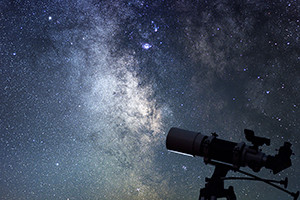Have you pondered the nature of planets, stars, galaxies and the universe? Astronomy is a branch of science that attempts to explain what we observe in our galaxy. It studies everything beyond our planet, from our own solar system's planets and stars to distant galaxies billions of light years away. This course will introduce you to astronomy and some approaches scientists use to observe the night sky. You'll learn about constellations, the celestial sphere and the celestial coordinate system that modern astronomers use to map stars, satellites, planets and other objects in space when viewed from Earth. Explore some of the best equipment for observing the night sky, such as telescopes and binoculars.
The Moon is a natural satellite and Earth's nearest celestial neighbour. Do you wonder why the Moon sometimes appears to be a crescent and other times full? Discover the Moon's history and formation, including its changing phases and colour-change phenomena. Discover its landscape features and physical characteristics. Investigate how and when to look for lunar phenomena and what you can expect to see. Have you been puzzled about the origin and causes of a shooting star? ‘Shooting star’s are meteors and this course explains the origins of meteors and meteorites, including where they come from and why they continue to fall on Earth. We'll show you the steps and the tell-tale signs used to identify a meteorite on the surface of the Earth.
Asteroids provide us with information about the Solar System's origins and pose a threat to life on Earth. Discover the difference between asteroids and other celestial bodies, the danger they pose, where they come from and how to spot them. We explain the history of comets and why they regularly revisit Earth, including the famous Halley's Comet. You will study the theory and evidence that supports the idea of a ‘Big Bang’ creating the universe. We'll also explore the notions and exploration of life outside of Earth. Find out what will become of the universe as we examine some theoretical suggestions of how the universe might end in the final part of this course. This course is open to all learners who want to understand the universe's characteristics. Research where we came from and where we are heading by examining the natural world beyond our planet. So why wait? Enrol now and learn for free!
What You Will Learn In This Free Course
View All Learning Outcomes View Less All Alison courses are free to enrol, study, and complete. To successfully complete this Certificate course and become an Alison Graduate, you need to achieve 80% or higher in each course assessment.
Once you have completed this Certificate course, you have the option to acquire an official Certificate, which is a great way to share your achievement with the world.
Your Alison certificate is:
- Ideal for sharing with potential employers.
- Great for your CV, professional social media profiles, and job applications.
- An indication of your commitment to continuously learn, upskill, and achieve high results.
- An incentive for you to continue empowering yourself through lifelong learning.
Alison offers 2 types of Certificate for completed Certificate courses:
- Digital Certificate: a downloadable Certificate in PDF format immediately available to you when you complete your purchase.
- Physical Certificate: a physical version of your officially branded and security-marked Certificate
All Certificate are available to purchase through the Alison Shop. For more information on purchasing Alison Certificate, please visit our FAQs. If you decide not to purchase your Alison Certificate, you can still demonstrate your achievement by sharing your Learner Record or Learner Achievement Verification, both of which are accessible from your Account Settings.
















 Avg. Hours
Avg. Hours  Contains Video
Contains Video  CPD Accredited
CPD Accredited 
 Total XP:
Total XP: 
 Knowledge & Skills You Will Learn
Knowledge & Skills You Will Learn 


